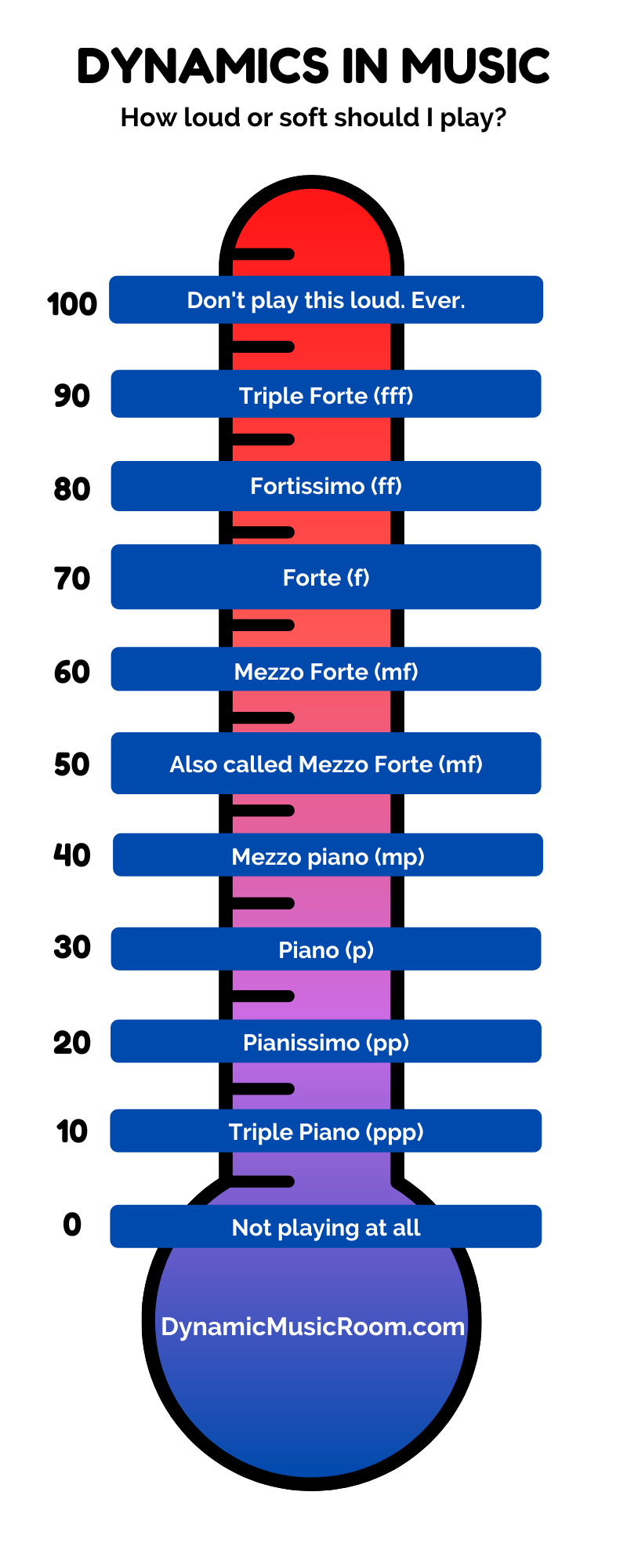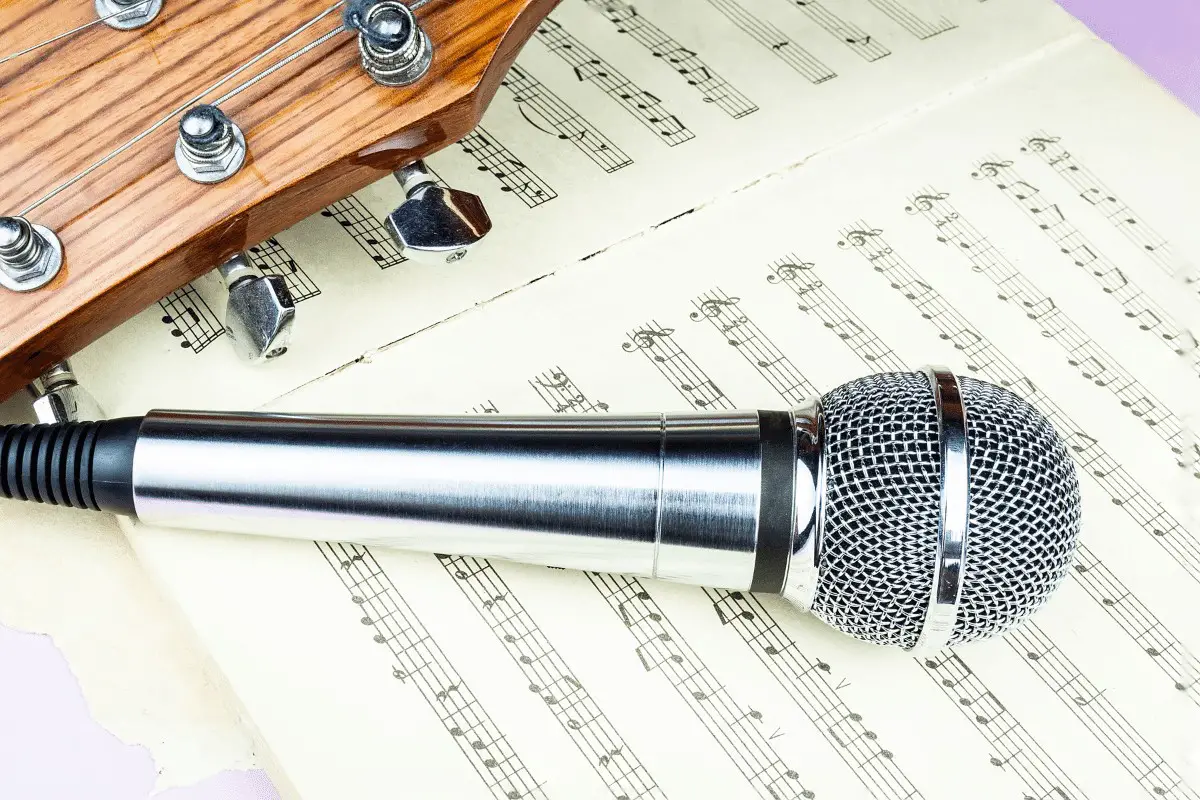Style and artistic expression are important aspects of music that sometimes get lost in the mix of all the pitches and rhythms you have to learn and play.
Markings like the dynamics are critical for true musicianship beyond notes and rhythms.
It’s also the changes in volume of the music that make each musical performance unique.
But what are the dynamics in music?
Dynamics in music tell us the volume of a sound or how loud or soft to play the music. These include written and unwritten rules. There are “static” dynamics like forte and piano, which are meant to stay generally the same, and “moving” dynamics which get louder and softer.
Let’s look ahead for a discussion of all the dynamic markings in music, what they mean, and some examples throughout.
Table of Contents
What Are Dynamics (Music Theory)?
Another word for dynamics is volume.
They essentially mean the same thing.
Much of the time, dynamics are written into the musical notation, but there are many times when professionals will add dynamic shifts to make the music more interesting.
Dynamics are also relative to the part called for.
For example, I play the tuba, and when I see a forte, I play strong (like you’re supposed to).
But my forte sounds different if I’m supporting a trumpet melody than a clarinet melody as this instrument is softer.
This is called a textual indication.
It also depends on the group too.
So the answer isn’t so clear.
For the main dynamic terms used in music, check out this handy chart.
| Italian Word/Music Term | Marking/Abbreviation | What It Means |
|---|---|---|
| Triple piano | ppp | Super soft |
| Pianoissimo | pp | Very soft |
| Piano | p | Soft |
| Mezzo piano | mp | Medium soft |
| Mezzo forte | mf | Medium strong |
| Forte | f | strong |
| Fortissimo | ff | Very strong |
| Triple forte | fff | Super strong |
| Crescendo | cresc. or < | Get louder |
| Decrescendo | decresc. or > | Get softer |
| Diminuendo | Dim. or > | Get softer |
Fun fact: The instrument called the piano was first called the pianoforte.
It was called this because it was the first keyboard instrument to be able to play both loud dynamics and soft dynamics (thus the name “soft-loud.”
History Of Dynamics In Music
When music and sheet music were first used, there weren’t really any dynamic markings.
At the most, you’d get a set of instructions before the music tells you how to play it.
It was up to you or the common practice for the type of music you were playing most of the time.
In the 16th century, dynamics started to be added in, but there weren’t standard music terms for how to play; it was in the language the music was written in.
During the 17th Century, Italy became the clear center of the musical world.
Performers from all over the known world came to study music here.
As such, their musical terms became the standard, and they’d start to show up in the musical score.
This is where the terms from above come into play.
(They are Italian words, after all!)
How To Show Or Indicate Dynamic Changes In Music

Static Dynamics And Markings
The static dynamic markings are the ones most people think about.
They cover the dynamic range of your voice or instrument.
These are the ones from the table and graphic earlier on, but we’ll go through them again here in a little more detail.
In music notation, you’ll generally see the markings marked as abbreviations of the main Italian dynamic terms.
Three main ones are:
- Forte (f) = Strong
- Mezzo (m) = Medium
- Piano (p) = Soft or quiet dynamic
All the other static, dynamic markings are combinations of these three terms.
On the quieter end, we have:
- Mezzo piano = Medium-soft
- Piano (p) = Soft sounds
- Pianissimo (pp) = Very soft
- Double pianissimo/Triple piano* (ppp) = Even softer
*This isn’t an actual dynamic term that would have been used.
But it’s risen in popularity with modern school band music.
For different dynamics on the louder end we have:
- Double fortissimo/Triple forte** (fff) = Even louder
- Fortissimo (ff) = Very strong
- Forte (f) = Strong
- Mezzoforte (mf) = Medium-strong
**This is the same as the triple piano; it’s not a real term.
Note: There is no “mezzo” dynamic.
It’s either mezzopiano or mezzoforte.
Mezzoforte is used to mark a true medium in many cases.
Moving Dynamic Markings
Moving dynamic markings indicate a broader change in dynamics.
These include:
- Crescendo (long <) = Gradual increase
- Decrescendo (long <) = Gradually gets softer
- Diminuendo (dim.) = Gradual change to the softer end
- Fortepiano (fp) = Play the note loud and then get instantly quieter
Crescendo decrescendo may be in different ways, such as marked by the word, the shortened version of the word, or by the marking.
If using the marking, you follow the direction of the marking for as long as the marking is written.
For example, if you see a crescendo marking stretched over 4 beats, you get louder for all 4 beats.
If using the term itself, it may be followed by a line or some dots.
Do the dynamic change for as long as you see dots.
If there are no dots indicating the length, get louder or softer until the next marked dynamic (or the next rehearsal letter or number).
Diminuendo is the same as a descrescendo, but it doesn’t have a marking (other than the same one).
Diminuendo is sometimes marked with its abbreviation (dim.).
Other accents and style marking may indicate a brief change in intensity and volume level, but they don’t necessarily make up true dynamics.
Fun fact: It was in the Romantic Period of music that more of these gradual dynamics were used.
Before this, it was usually terraced dynamics that just switched from loud to soft with sudden emphasis with each section of music.
Unwritten Dynamic Rules In Music
If figuring the right rhythm, pitch, key, style, phrasing, dynamics, etc., wasn’t tough enough, there are even some unwritten rules in music you should probably know about around dynamics.
A lot of these have to do with the context of the music as you play.
This is part of what makes a big difference between the pros and amateurs.
Here are a few of the most common ones:
- When you have a long note, it needs to grow toward the end unless otherwise marked.
- If you have long notes, get softer at the beginning of the note to allow the melody to shine through.
- With three or more repeated notes, either get louder or softer depending on how it feels best with the music.
- If you have the melody, add some dynamics getting louder or softer or both to make it more interesting.
- When a melody plays higher, get louder. When it plays lower, it gets softer (in most cases).
- If you don’t have a dynamic marked and another section does, follow them and do what they do (just not as extreme).
- Do what the conductor conducts, even if the written dynamics are different.
- When performing a crescendo, save the bulk of the growth for the last 30% of the crescendo. Don’t get too loud right away.
- Unless written, crescendo or decrescendo to the next dynamic mark (crescendo from piano to mezzo-piano, for example).
- Start a crescendo softer to allow for more contrast in the music.
Examples Of Dynamics In Music
A lot of this information on dynamics is easier to understand through practice and listening.
Listening to music, in general, is the best way to improve your understanding (outside of practice).
Here are a few of my favorite pieces to listen to with a wide contrast in their dynamics:
- In The Hall Of The Mountain King – Gradual crescendo the entire time.
- Hungarian Dance No. 5 – Widely changing sections with dynamics.
- “Surprise” Symphony – Mostly piano with a surprising forte! This is a very famous piece of the Baroque period.
- Stars And Stripes Forever – The trio gets very quiet (pianissimo).
- Pictures At An Exhibition: The Hut On Fowl’s Legs – Two varied sections at forte and piano.
- …and more in my classical music song examples with dynamics article.
Popular music changes subtle degrees of loudness rather using the extreme range of the volume of music possible.
This is partly due to the nature of popular music.
The song was meant to played on the radio or listened to with headphones.
If it gets wildly loud or soft, you’ll be adjusting your volume for the entire piece .
This is why we have more subtle changes here.
Though things do usually get louder in the second time we hear a verse and chorus.
What Does SF in Music Mean?
A lot of folks sort the sforzando (also spelled sforzato, forzando, or forzato) into the dynamics category.
I don’t totally agree with this, but it works for most people.
In general, when you see this, you want to play the note suddenly louder.
So in a way, this is a dynamic marking.
But I feel it’s more like a style marking, such as the accent.
These do affect the dynamics, but that’s not all it entails.
It’s more about the sudden change than the volume itself.
Plus, they only really affect a single note.
Sforzando is marked as sf, sfz, and fz at times.

